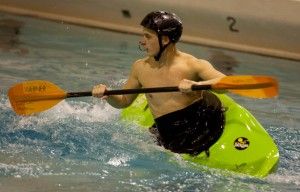Snapping and rolling with the kayak club

February 9, 2012
Upside down and underwater with my lower body squeezed into a tight kayak cockpit, the motions needed to right the boat seem counterintuitive as I struggle to flip up toward the oxygen my lungs craved.
Luckily, I was in the shallow end of Pulliam’s Pool and a spotter from the SIU Kayak Club was nearby in case I couldn’t right myself the way I’d been shown: by snapping my hips.
The ability to right the kayak when it flips is essential for anyone who wants to run a wild river, and the Kayak Club teaches those skills. The club meets at 7 p.m. each Thursday at the Pulliam Pool. Kayaks and gear are available, and club leaders don’t mind helping new members with their technique.
Advertisement
“Guys always want to use too much upper body,” said club president Alexis Irlam, a senior from Virginia studying outdoor recreation. “You snap your hips first, and then pull the rest of your body out of the water.”
Once you begin to treat the roll as a dance move of sorts, she said, you begin to use less power and more finesse.
Sarah Dorau, a junior from Muncie, Ind. studying blacksmithing and ceramics, said she scheduled her spring semester courses around the club’s meeting time. Dorau, a first-time visitor as well, said a summer whitewater-rafting trip prompted her to get into a kayak and onto the river as fast as possible.
“I loved the whitewater,” Dorau said. “The guys in the kayaks looked like they were having the most fun on the river.”
With spring on the way, club members are gearing up for trips down the St. Charles River in southern Missouri and Lusk Creek, an hour and a half west of Carbondale.
Before tackling whitewater rafting, first-timers should get some instruction.
Both Irlam and vice president Zach Thomas, a junior from Algonquin studying criminology, gave a brief tutorial on how to properly hold the paddle and eject yourself from the kayak if unable to roll it over.
Advertisement*
Promptly after the briefing, we were pushed into the pool for an evening of disorienting rolls and swimmer’s ear.
Whitewater kayaks differ from recreational and sea kayaks by their size and agile handling, which is ideal for navigating rapids. However, the possibility of ending up underwater means learning how to roll upright before attempting to brave whitewater.
The spray skirt, a watertight cloth wrapped around the kayak’s cockpit, hems inside to keep the water out once upside down. To squeeze my 6-foot-3-inch frame into a whitewater kayak is as much of a task as the roll itself, but excuses don’t flip kayaks.
Resilience proves to be the key to a successful roll. As each flip gets harder and sore muscles become a testament to a night with the Kayak Club, the ability to build one’s self up through trial and error helps detour future difficulties on the river in a way that only first-hand experience can.
Advertisement








